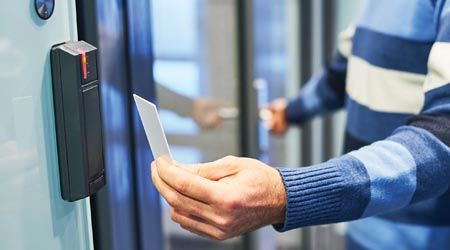It’s summertime, and some of you might have kids home from school, and family vacations scheduled in the coming weeks. As past experience tells me, the likelihood of running into an access control system while on vacation remains extremely high. From the key fob to access the condo pool, to the door code to enter your VRBO, keys and codes are a part of vacationing. Access control systems are not only part of vacationing, but they are also part of our daily professional and personal life. Access control systems are here to stay and are trending into the future.
Access control systems are essential components for ensuring security and managing access to various resources, both in professional and personal settings. From our day job to returning home after work we’re guaranteed to run into a lock or something password protected. Here are a few differences of access control systems from our professional to personal life, along with the anticipated future trends.
Professional Settings
Digital Access Control
- User Authentication Systems: Passwords, multi-factor authentication (MFA), and single sign-on (SSO) systems to control access to digital resources.
- Role-Based Access Control (RBAC): Permissions assigned based on the roles of employees, ensuring they have access only to the information necessary for their job functions.
Network and Data Security
- Firewalls and Intrusion Detection Systems: Protect company networks from unauthorized access and cyber threats.
- Encryption: Used to protect sensitive data both in transit and at rest.
Enterprise Resource Planning (ERP) Systems
- Access Control Modules: Integrated into ERP systems to ensure that employees have access to the resources necessary for their job while restricting access to sensitive information.
Personal Settings
Physical Access Control
- Locks and Keys: The most basic form of access control, used for securing homes, cars, and safes.
- Smart Locks: Advanced versions of traditional locks that can be controlled via smartphones, providing keyless entry and the ability to grant temporary access to others.
Digital Access Control
- Password Protection: Used for securing personal devices like smartphones, laptops, and personal accounts on various platforms.
- Biometric Authentication: Fingerprint scanners, facial recognition, and iris scanners are increasingly used for securing personal devices and applications.
Network and Data Security
- Wi-Fi Security: Personal Wi-Fi networks protected by passwords and encryption protocols like WPA3.
- Home Security Systems: Integrated systems that include cameras, motion sensors, and alarms, often controlled remotely via smartphones.
As we enjoy the protection, we get from the systems that are available now, we can look forward to what the future trends have in store for us.
Future Trends
- Biometric Advancements: Increasing use of advanced biometric systems for both personal and professional access control.
- Artificial Intelligence: Enhanced security through AI-driven monitoring and response systems that can predict and prevent unauthorized access attempts.
- Cloud-Based Access Control: More systems are moving to the cloud, offering scalability, remote management, and integration with other cloud services.
Access control systems are evolving rapidly, providing greater security and convenience in both professional and personal environments. The choice of system depends on the specific needs, the level of security required, and the resources available for implementation and maintenance.

